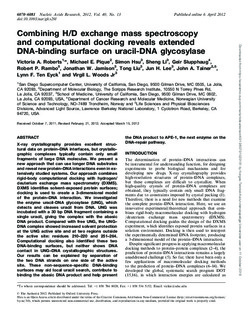| dc.contributor.author | Roberts, Victoria A. | |
| dc.contributor.author | Pique, Michael E. | |
| dc.contributor.author | Hsu, Simon | |
| dc.contributor.author | Li, Sheng | |
| dc.contributor.author | Slupphaug, Geir | |
| dc.contributor.author | Rambo, Robert P. | |
| dc.contributor.author | Jamison, Jonathan P. | |
| dc.contributor.author | Liu, Tong | |
| dc.contributor.author | Lee, Jun H. | |
| dc.contributor.author | Tainer, John A. | |
| dc.contributor.author | Ten Eyck, Lynn F. | |
| dc.contributor.author | Woods Jr., Virgil L. | |
| dc.date.accessioned | 2019-10-14T07:05:05Z | |
| dc.date.available | 2019-10-14T07:05:05Z | |
| dc.date.created | 2012-06-12T10:07:31Z | |
| dc.date.issued | 2012 | |
| dc.identifier.citation | Nucleic Acids Research. 2012, 40 (13), 6070-6081. | nb_NO |
| dc.identifier.issn | 0305-1048 | |
| dc.identifier.uri | http://hdl.handle.net/11250/2621810 | |
| dc.description.abstract | X-ray crystallography provides excellent structural data on protein–DNA interfaces, but crystallographic complexes typically contain only small fragments of large DNA molecules. We present a new approach that can use longer DNA substrates and reveal new protein–DNA interactions even in extensively studied systems. Our approach combines rigid-body computational docking with hydrogen/deuterium exchange mass spectrometry (DXMS). DXMS identifies solvent-exposed protein surfaces; docking is used to create a 3-dimensional model of the protein–DNA interaction. We investigated the enzyme uracil-DNA glycosylase (UNG), which detects and cleaves uracil from DNA. UNG was incubated with a 30 bp DNA fragment containing a single uracil, giving the complex with the abasic DNA product. Compared with free UNG, the UNG–DNA complex showed increased solvent protection at the UNG active site and at two regions outside the active site: residues 210–220 and 251–264. Computational docking also identified these two DNA-binding surfaces, but neither shows DNA contact in UNG–DNA crystallographic structures. Our results can be explained by separation of the two DNA strands on one side of the active site. These non-sequence-specific DNA-binding surfaces may aid local uracil search, contribute to binding the abasic DNA product and help present the DNA product to APE-1, the next enzyme on the DNA-repair pathway. | nb_NO |
| dc.language.iso | eng | nb_NO |
| dc.publisher | Oxford University Press | nb_NO |
| dc.rights | Navngivelse-Ikkekommersiell 4.0 Internasjonal | * |
| dc.rights.uri | http://creativecommons.org/licenses/by-nc/4.0/deed.no | * |
| dc.title | Combining H/D exchange mass spectroscopy and computational docking reveals extended DNA-binding surface on uracil-DNA glycosylase | nb_NO |
| dc.type | Journal article | nb_NO |
| dc.type | Peer reviewed | nb_NO |
| dc.description.version | publishedVersion | nb_NO |
| dc.source.pagenumber | 6070-6081 | nb_NO |
| dc.source.volume | 40 | nb_NO |
| dc.source.journal | Nucleic Acids Research | nb_NO |
| dc.source.issue | 13 | nb_NO |
| dc.identifier.doi | 10.1093/nar/gks291 | |
| dc.identifier.cristin | 929033 | |
| dc.description.localcode | Open Access. This article is available under the Creative Commons CC-BY-NC license and permits non-commercial use, distribution and reproduction in any medium, provided the original work is properly cited. | nb_NO |
| cristin.unitcode | 194,65,15,0 | |
| cristin.unitname | Institutt for klinisk og molekylær medisin | |
| cristin.ispublished | true | |
| cristin.fulltext | original | |
| cristin.qualitycode | 2 | |

